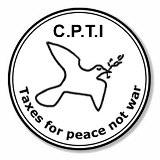War Tax Resistance (WTR) in the USA was mostly based in the historic peace churches until World War II. These churches include the Society of Friends (The Quakers), the Mennonites and the Brethren. The Quakers were especially opposed to paying for war as long ago as colonial times and during the Revolutionary War (1670s – 1783). Where the Boston Tea Party saw mass opposition to paying tax to the British crown, individuals in these peace churches
were the only ones opposed to paying for war in general. There was an instance of the relatively peaceful Algonquin Indians refusing to pay for the improvements of a local Dutch fort in 1637 and this is one of the earliest examples of WTR.
The War of 1812 (1812-1815) and the Mexican American War (1846-1848) saw continued WTR by Quakers especially and many were jailed for their refusal to pay for killing. Noted writer Henry David Thoreau was jailed for his refusal to pay the poll tax destined for the war. His essay On the Duty of Civil Disobedience
had a profound effect on many. The Civil War (1861-1865) saw a large decrease in WTR even from the peace churches. Paying for war was seen as necessary by many in order to free the slaves.
During World War I (1917-1919) there was mixed resistance to the sale of War Bonds yet this was mostly by the historic peace churches as well. When the income tax was established in 1913 it affected only a small percentage of the population. There was no resistance on record to its initiation. In 1923, the War Resisters League was founded by a group who sought to create a mass movement based on the idea that war will end when individuals withhold their participation.
Leading up to World War II (1941-1945) very few people paid individual income tax. In 1939 only 3% of the population qualified as needing to pay. By 1945 this number had jumped to 36%. Many pacifists were spurred by this huge increase in government income and spending for war and several groups including Women's International League for Peace and Freedom (WILPF) and American Friends Service Committee (AFSC) protested the Defense Tax
of 10% added onto the income tax in 1941. And in 1949 nationwide publicity was made for the first time by a group of 40 people who refused to pay all or part of their income tax.
The Korean War (1950-1953) saw WTR gaining some notoriety with the publication of the Handbook on Nonpayment of War Taxes by a group called Peacemakers. This was the first document of its kind in the USA.
War Tax Resistance peaked during the Indochina (Vietnam) War (1964-1975) with some 20,000 income tax resisters and between 200,000 to 500,000 phone tax resisters. Organizing efforts became widespread to encourage people to stop paying the war tax
on the phone bill and to commit to not paying income taxes destined for the war. The Campaign for a Peace Tax Fund began in 1971, pushing for federal legislation to validate conscientious opposition to payment for war by providing a way to pay taxes for peaceful purposes.
The increase in nuclear arms production starting in the late 1970s saw a renewed call to peacemaking. While the numbers of WTRs had diminished after the end of the Indochina War, they actually tripled with the election of President Ronald Reagan in 1980. 1982 saw the creation of the National War Tax Resistance Coordinating Committee (NWTRCC) to aid the many WTR groups springing up around the country.
There are between 8000 and 10,000 people conscientiously resisting the payment of part or all of their income taxes currently in the USA. This is according to IRS figures. The actual numbers are probably higher especially after the start of the Iraq War over a year ago. Many people seem to resist on their own without being part of a WTR group.
(Note: Most of this info was taken from War Tax Resistance
published by War Resisters League in USA www.warresisters.org).
